Working Conditions in the coastal diamond mines
Kleinzee, CDM and Alexcorp
In the picture below a miner is looking for
diamonds in rock cavities along a shore that were buried under sand-dunes
before large excavators laid them bare. In is a land of heat, wind and frequent
dust storms. When I met this man he was one of a team working in gale-force
winds. He holds a metal pick and a brush - with which he searches every tiny
crack in and between the rocks in case a diamond has been trapped in it. He
works bent over for hours every day.
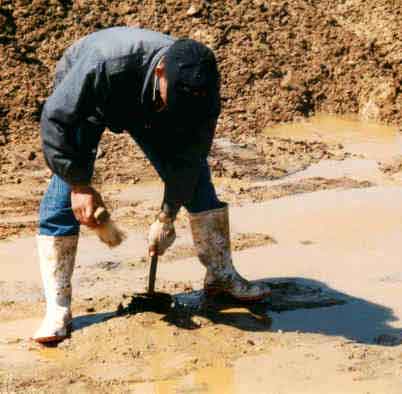
The sign below is at the start of a road of
over 100 miles that runs through several De Beers mining towns including Kleinzee
that line the Atlantic coast of South Africa. It is effectively a small state
run by De Beers. Kleinzee is nearly 20 miles from public roads. I travelled
from mining town to town down this road as a guest of the Mineworkers Union
before De Beers management realised I was in South Africa and warned that I
was not to be admitted.
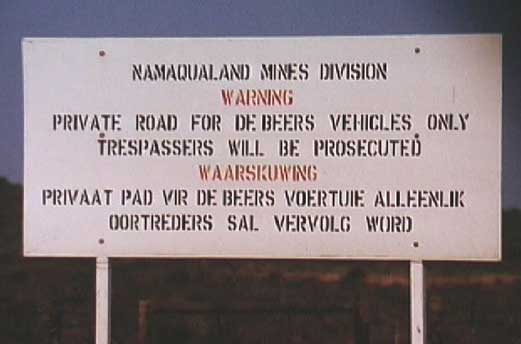
Inside this De Beers empire the most stringent
precautions are taken to ensure that no mineworker keeps a diamond. If an ostrich
is hit by a car, no workeris allowed to touch it - for fear that it might have
swallowed a diamond. Instead it is taken away by De Beers security.
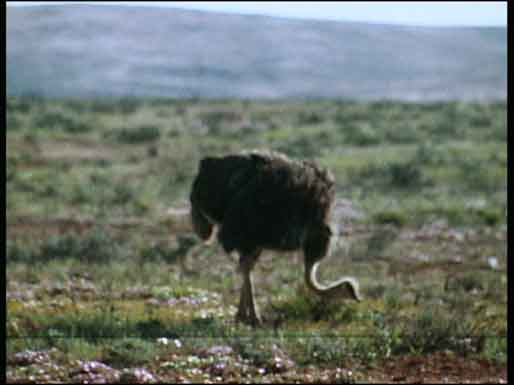
Diamond miners are nearly entirely Black
or Coloured. The workers on the lowest rates, the A and the B Bands, are practically
entirely Black. No worker on these rates is allowed married quarters in the
De Beers mining towns (unless as a servant) - such accomodation is preserved
entirely for White or Coloured workers. This system is in practice apartheid
by another name. Black workers bitterlycomplain that this discrimination breaks
up their families. It may be months between visits to families. If a wife of
these Black workers gets a job in the mining town, she must stay in single women's
quarters - and they are punished if they are found to have slept together. There
are a few holiday married quarters - where a man and wife can meet - but these
need to be booked often a year or more in advance. None of these restrictions
apply to White workers . since these are practically entirely on the higher
wage bands. The women and children below were waiting outside the mine gate
to have a word with their husbands and fathers.
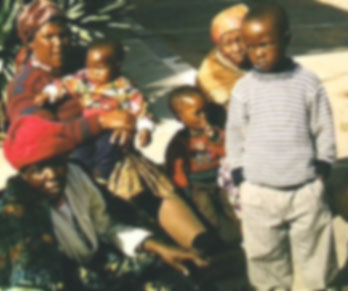
I drove a wife who came to briefly talk
to her husband at the mine's gate back to where she lived in the shanty town
below - over 50 miles away.
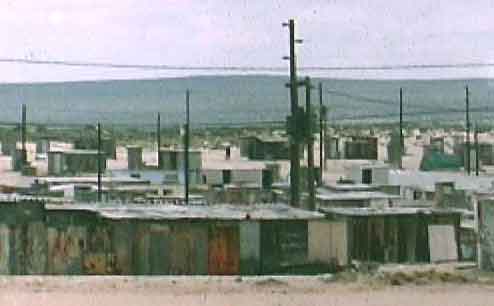
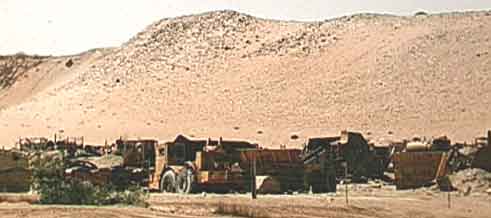
Cars that are used within the diamond mining
town are not allowed to leave lest they be used for diamond smuggling. The old
vehicles above are awaiting burial. Under apartheid, if a black miner died,
his body was not allowed to leave the mine lest it too be used to smuggle diamonds.
This is the apartheid era prison-like accomodation at Kleinzee with its fences,
floodlights and (out of picture) its watchtowers.
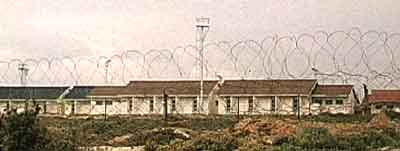
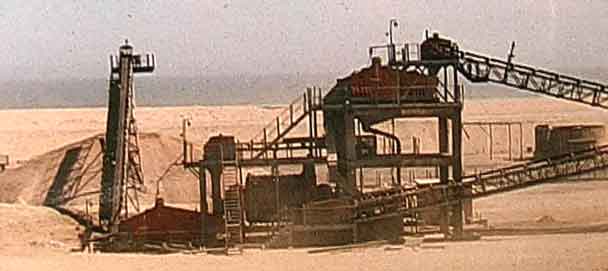
Above is one of the Kleinzee processing plants
- sorting diamonds out of the gravels and sands along the coast. Vast stretches
of the sand-dunes are cleared, exposing the buried former rocky shorelines -
as in the Kleinzee photo below.
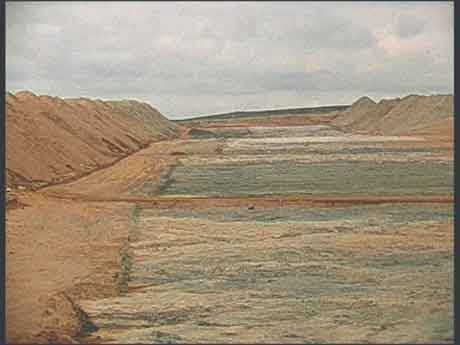
Then the Black mineworkers go over the rocks,
first with giant vacuum cleaners like that being used below, getting all the
diamond rich gravels out from the crevices and potholes in the newly exposed
rocks.
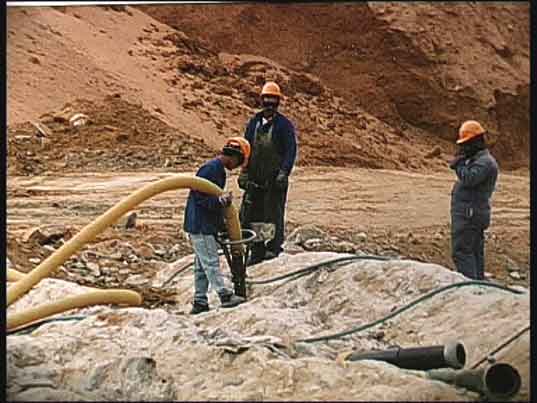
The vacuum hoses go into yellow safes on wheels
- protecting the diamonds from being smuggled out by the mineworkers.
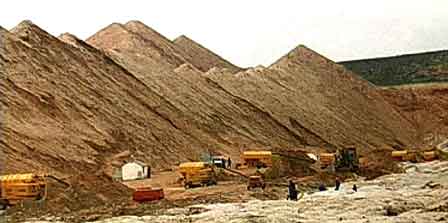
when the larger cracks have been cleaned, then
sweepers go over with pricks in one hand and a brush in the other. These had
just worked right through a violent sandstorm.
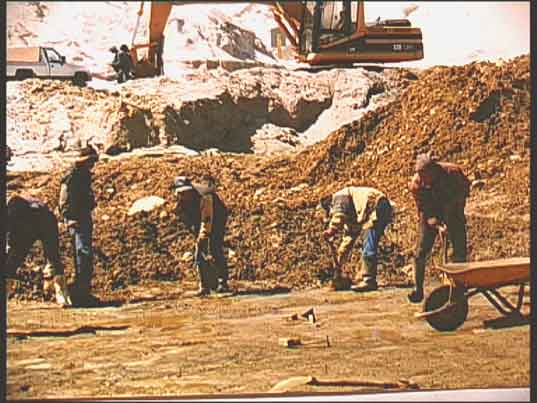
At Kleinzee De Beers was telling the Government
that the mine had nearly run out of diamonds so could not pay into government
welfare schemes - this was partly to forestall any government plans to tax the
mines more heavily or to take them over. De Beers was in fact planning to shift
production to offshore ships that could vacuum up diamonds from the seafloor
off shore from Klieinzee sometimes 10 to 30 carats of diamonds for every kilogram
of gravel. The work force on the ships was not unionised - and De Beers would
have a great deal more ability to keep secret whatever it sucked up.
In fact De Beers had a superfluity of diamonds
- and had actually hidden some of its Kleinzee diamond reserves so that no one
would think of mining them. This was an old strategy. Diamonds were supposedly
highly prices because of their rarity.
De Beers's plan was cunning. It had set aside
part of its mining reserve as a game park - as shown in the photo below. This
was not an area particularly rich in wildlife so De Beers shipped in some animals.
But according to Kleinzee geologists, it was rich in diamonds - containing enough
to keep the mine going for many years. De Beers expected that the environmental
lobbey would help it keep this new nature park unmined. After learning of this
park, I drove south down De Beers private road for some miles until I found
it. It was evident that De Beers was quietly exploring its own park - for it
had mining exploration equipment next to its gate as shown by the photograph
below- and I could see the diamond drilling exploration rigs within the park.
These drill pipes are very wide - for after they have drilled down through the
sand drifts to the buried shoreline, they send miners down the pipes to suck
up with the vacuum gear standing by the gate all the diamond-rich gravels they
exposed. Similar"nature parks" were also set up near other mines to
hide diamond resources.
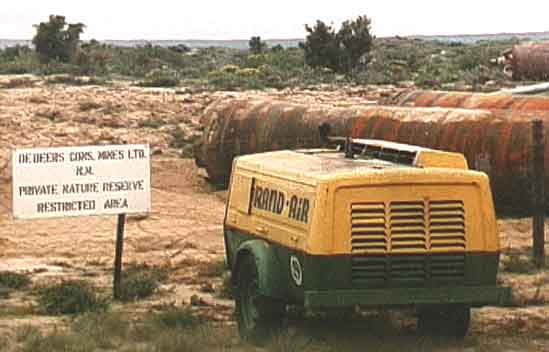
The exposed rocks below are part of the famous
"Oyster Line" at the Alexcorp mine. This is incredibly rich in diamonds
- with scores of first-class diamonds found under many of its rocks. It made
Ernest Oppenheimer extremely worried when it was first discovered - he was frightened
that it might force the price of diamonds down. But soon it was reserved as
a future resource , that is until shortly before I went to visit it. It was
now being much more quickly mined. This mine was not owned by De Beers but had
contracted to sell all its diamonds to De Beers. It had agreed with De Beers
to artifically limit its production to not more than a small fraction of what
was produced by the major De Beers mines to its north and south. De Beers is
currently trying to buy control of it.
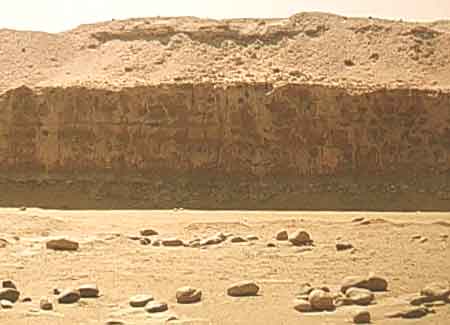
Here for De Beers koffiefontein diamond
mine.
Here for
the Children who cut Diamonds for 25c a stone -in slavery as defined by the
UN
Click here for extra Koffiefontein diamond
mine photos
Click here for extra Kimberley region
diamond mine photos
Click here for Kimberley photos
Click her to go back to the home
page for this diamond website
To Contact the Author Janine F. Roberts Tap
Here
c2002 Janine Roberts
All Photos by Janine Roberts c2002 All Rights Reserved














